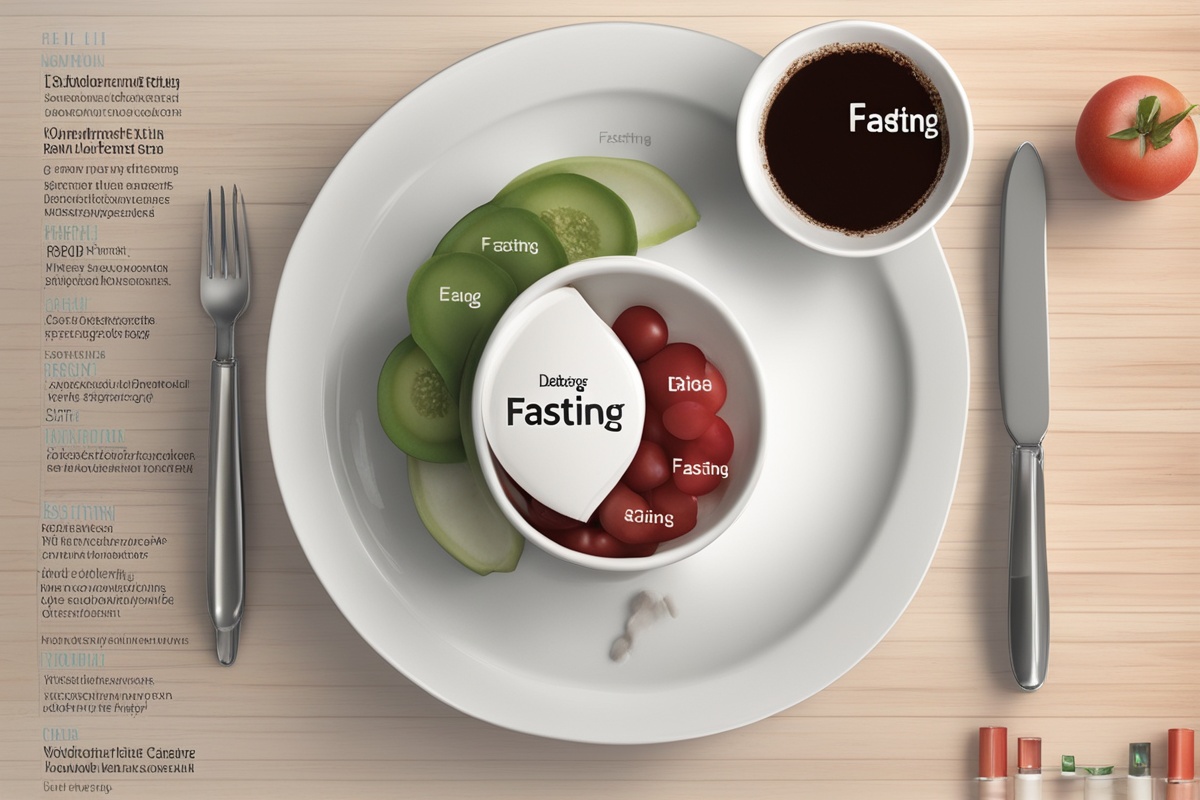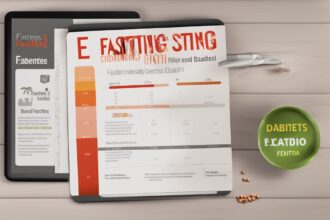Diabetes is a chronic condition affecting millions worldwide, and managing it often feels like walking a tightrope. If you’ve been searching for innovative ways to control blood sugar levels, you might have stumbled upon the concept of fasting. Yes, fasting for diabetes is gaining traction as a potential strategy to improve insulin sensitivity and stabilize glucose levels. But is it safe? How does it work? And can it fit into your lifestyle? In this comprehensive guide, I’ll walk you through the science behind fasting and diabetes management, share practical tips for integrating fasting into your routine, and highlight precautions to ensure you’re doing it safely. Whether you’re living with type 2 diabetes or supporting a loved one, let’s dive into how fasting could be a game-changer—when done right.
What Is Fasting, and How Does It Relate to Diabetes?
Fasting is the voluntary abstention from food and, sometimes, drink for a specific period. It’s been practiced for centuries across cultures for spiritual, health, and even therapeutic reasons. Today, intermittent fasting (IF)—a pattern of cycling between eating and fasting periods—has become popular for weight loss and metabolic health. For those with diabetes, particularly type 2, fasting for diabetes management is being studied as a way to improve insulin sensitivity and reduce blood sugar spikes (Mattson et al., 2017). The idea is simple: by giving your body a break from constant food intake, you allow it to reset metabolic processes, potentially lowering insulin resistance over time.
However, diabetes is a complex condition, and fasting isn’t a one-size-fits-all solution. While some studies suggest benefits like better glycemic control, others caution against risks such as hypoglycemia, especially for those on certain medications (Furmli et al., 2018). So, before you jump in, it’s critical to understand the mechanisms at play and consult with your healthcare provider.
The Science Behind Fasting for Diabetes Management
Let’s break down how fasting might help with diabetes. When you fast, your body shifts from using glucose as its primary energy source to burning stored fats through a process called ketosis. This switch can reduce insulin demand and improve insulin sensitivity, a key factor in type 2 diabetes (Anton et al., 2018). Additionally, fasting often leads to weight loss, which is crucial since excess body fat is linked to insulin resistance (American Diabetes Association, 2020).
Moreover, fasting may lower inflammation—a contributing factor to diabetes complications. Research indicates that intermittent fasting can decrease markers of inflammation in the body, potentially protecting against long-term issues like cardiovascular disease (Patterson & Sears, 2017). But here’s the catch: while these benefits sound promising, fasting for diabetes isn’t without risks. Sudden drops in blood sugar or dehydration can be dangerous, especially for those with type 1 diabetes or on insulin therapy. That’s why personalized guidance is non-negotiable.
Types of Fasting Suitable for Diabetes Patients
Not all fasting methods are created equal, especially when managing diabetes. Here are a few approaches that might work for diabetes control, provided they’re tailored to your health needs:
- 16/8 Intermittent Fasting: Fast for 16 hours and eat during an 8-hour window. This can help regulate blood sugar by limiting eating frequency without extreme calorie cuts.
- 5:2 Fasting: Eat normally for 5 days and restrict calories (500-600) on 2 non-consecutive days. This method may support weight loss and improve insulin sensitivity.
- Time-Restricted Eating (TRE): Similar to 16/8, TRE focuses on eating within a shorter daily window (e.g., 10 hours), aligning meals with your body’s circadian rhythm for better metabolic health.
- Alternate-Day Fasting: Alternate between normal eating days and very low-calorie days. This can be effective but may be harder to sustain long-term.
Choosing the right fasting method depends on your lifestyle, diabetes type, and medication schedule. For instance, shorter fasting windows might be safer for beginners or those prone to low blood sugar. Always start slow and monitor how your body responds.
Practical Tips for Safe Fasting with Diabetes
If you’re considering fasting for diabetes, safety comes first. Here are actionable steps to integrate fasting into your routine without compromising your health:
- Consult Your Doctor: Before starting any fasting regimen, speak with your healthcare provider or a dietitian. They can adjust medications like insulin or sulfonylureas to prevent hypoglycemia.
- Monitor Blood Sugar Closely: Use a glucometer to check glucose levels frequently, especially during fasting periods. Look out for signs of low blood sugar, such as dizziness or sweating.
- Stay Hydrated: Drink plenty of water during fasting windows to avoid dehydration, which can worsen blood sugar control.
- Break Fasts Smartly: When ending a fast, opt for nutrient-dense foods like lean protein, vegetables, and whole grains to prevent blood sugar spikes.
- Start Small: If you’re new to fasting and diabetes management, begin with shorter fasting periods (e.g., 12 hours overnight) and gradually increase as your body adjusts.
Remember, fasting isn’t about starvation—it’s about strategic timing. Pairing it with a balanced diet and regular physical activity can amplify its benefits for blood sugar regulation.
Potential Risks and How to Mitigate Them
While fasting for diabetes shows promise, it’s not risk-free. One major concern is hypoglycemia, especially for those on insulin or certain oral medications. Fasting can also lead to dehydration or nutrient deficiencies if not planned properly (Grajower & Horne, 2019). Additionally, some people might experience irritability or fatigue during fasting, which can affect daily life.
To mitigate these risks, never skip medical advice. Work with a healthcare team to create a fasting plan that accounts for your medication, activity levels, and overall health. If you feel unwell at any point—whether it’s extreme hunger, shakiness, or confusion—break your fast immediately with a small, balanced meal. It’s also wise to avoid fasting during illness or high-stress periods, as these can exacerbate blood sugar fluctuations.
Who Should Avoid Fasting for Diabetes?
Fasting isn’t for everyone, especially when it comes to diabetes management. Certain groups should approach it with extra caution or avoid it altogether. For instance, individuals with type 1 diabetes are at higher risk of dangerous blood sugar lows and diabetic ketoacidosis during fasting (American Diabetes Association, 2020). Pregnant or breastfeeding women with diabetes, as well as those with a history of eating disorders, should also steer clear unless under strict medical supervision.
If you have complications like kidney disease or heart issues, fasting could strain your system further. The key takeaway? Personalization is everything. What works for one person might be harmful to another, so prioritize your unique health profile over trending diet fads.
Studies Supporting Fasting for Diabetes
Research into fasting and diabetes management is growing, with promising results. A 2018 study published in BMJ Case Reports followed three patients with type 2 diabetes who practiced intermittent fasting under medical supervision. After several months, all participants reduced or eliminated their need for insulin, alongside significant weight loss and improved HbA1c levels (Furmli et al., 2018). While this is a small sample, it highlights fasting’s potential for reversing insulin dependency in some cases. Another study in Obesity (2016) examined time-restricted feeding in prediabetic individuals, finding that a 10-hour eating window improved insulin sensitivity and reduced blood pressure without major dietary changes (Sutton et al., 2018). These findings suggest that structured fasting could be a powerful tool, though larger, long-term studies are needed to confirm safety and efficacy across diverse populations.
In wrapping up, fasting for diabetes offers a fascinating avenue for managing blood sugar and improving metabolic health, but it’s not a magic bullet. The science shows potential benefits like enhanced insulin sensitivity and weight loss, yet the risks—such as hypoglycemia or dehydration—mean it must be approached with caution and professional guidance. By starting small, monitoring your body’s signals, and prioritizing safety, you can explore whether fasting fits into your diabetes management plan. Have you considered trying intermittent fasting, or do you have concerns holding you back? I’d love to hear your thoughts in the comments. Remember, managing diabetes is a journey, and every step toward better health counts.
References
- American Diabetes Association. (2020). Standards of Medical Care in Diabetes—2020. Diabetes Care, 43(Suppl 1), S1-S212.
- Anton, S. D., Moehl, K., Donahoo, W. T., et al. (2018). Flipping the metabolic switch: Understanding and applying the health benefits of fasting. Obesity, 26(2), 254-268.
- BMJ Case Reports, bcr-2017-221854.
- Grajower, M. M., & Horne, B. D. (2019). Clinical management of intermittent fasting in patients with diabetes mellitus. Nutrients, 11(4), 873.
- Mattson, M. P., Longo, V. D., & Harvie, M. (2017). Impact of intermittent fasting on health and disease processes. Ageing Research Reviews, 39, 46-58.
- Annual Review of Nutrition, 37, 371-393.
- Sutton, E. F., Beyl, R., Early, K. S., et al. (2018). Early time-restricted feeding improves insulin sensitivity, blood pressure, and oxidative stress even without weight loss in men with prediabetes. Cell Metabolism, 27(6), 1212-1221.






